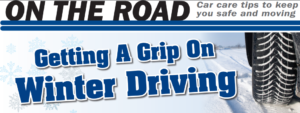 With the end of daylight savings and a definite chill in the air, you may be thinking about your winter tire options. As a brief overview there are 2 main winter tire choices, studs, studless, and then there are “all season” tires. Each has their benefits and constraints and your choice should be based on what conditions you mainly drive in. An easy way to make sure the tire you purchase is rated as a winter tire is to look for the “snowflake-in-a-mountain” symbol on the sidewall of the tire. A good set of winter tires on all four wheels regardless of whether your vehicle is front, rear or all wheel drive will improve handling and traction on snow and ice. The National Highway Traffic Safety Administration, and in fact most owner’s manuals recommend installing four winter tires so you maintain the most balanced and controlled handling possible in all winter driving conditions. It is imperative to keep the same level of traction at all four corners of the car; otherwise, the full benefits of ABS or traction control systems will be lost. Below is a quick list of pros and cons of each type of winter tire.
With the end of daylight savings and a definite chill in the air, you may be thinking about your winter tire options. As a brief overview there are 2 main winter tire choices, studs, studless, and then there are “all season” tires. Each has their benefits and constraints and your choice should be based on what conditions you mainly drive in. An easy way to make sure the tire you purchase is rated as a winter tire is to look for the “snowflake-in-a-mountain” symbol on the sidewall of the tire. A good set of winter tires on all four wheels regardless of whether your vehicle is front, rear or all wheel drive will improve handling and traction on snow and ice. The National Highway Traffic Safety Administration, and in fact most owner’s manuals recommend installing four winter tires so you maintain the most balanced and controlled handling possible in all winter driving conditions. It is imperative to keep the same level of traction at all four corners of the car; otherwise, the full benefits of ABS or traction control systems will be lost. Below is a quick list of pros and cons of each type of winter tire.
All Season Tires
Pros: Can be used all year round
Cons: Does not provide enough traction in snow or icy conditions
Studs
Pros: Good traction on ice and hard packed snow
Cons: Loud, do not handle well on wet or dry pavement, damages roads.
Additionally, studded snow tires are only permitted on Nevada roads between October 1st and April 30th
Studless
Pros: Good traction in all winter conditions, quiet, remain flexible in temperatures down -22 degrees, rubber is porous preventing a film of water generating over the tire.
Cons: May be less durable, expensive
Regardless of your choice, as part of the care of your winter tires you should monitor your tire pressure as outlined in your driver’s manual, this is a requirement for good handling, traction and durability. It is particularly important to monitor tire pressure in winter as for every 10 degree change in temperature; tire pressure will change by 1psi. Some manufacturers even recommend filling 3-5 psi higher than you would in the summer time as it may increase tire stability and help offset the reduction in responsiveness due to the softer materials winter tires are made of. You may even wish to consider filling your tires with nitrogen as this gas helps to maintain a more consistent tire pressure and is less affected by temperature variations. An additional tip for maintaining tire pressure is to keep the valve caps on to prevent moisture entering and freezing allowing air to escape. To prevent excessive wear of your winter tires make sure your wheels are in alignment. Wear occurs because winter tires are made of softer rubber and have more aggressive tread designs. Of the normal alignment settings camber and toe settings have the most affect on wear of winter tires.
When not using your winter tires you should make sure they are protected from heat, light, moisture and deformation during storage.
Want to know more car care knowledge? Check out more of our articles here!
